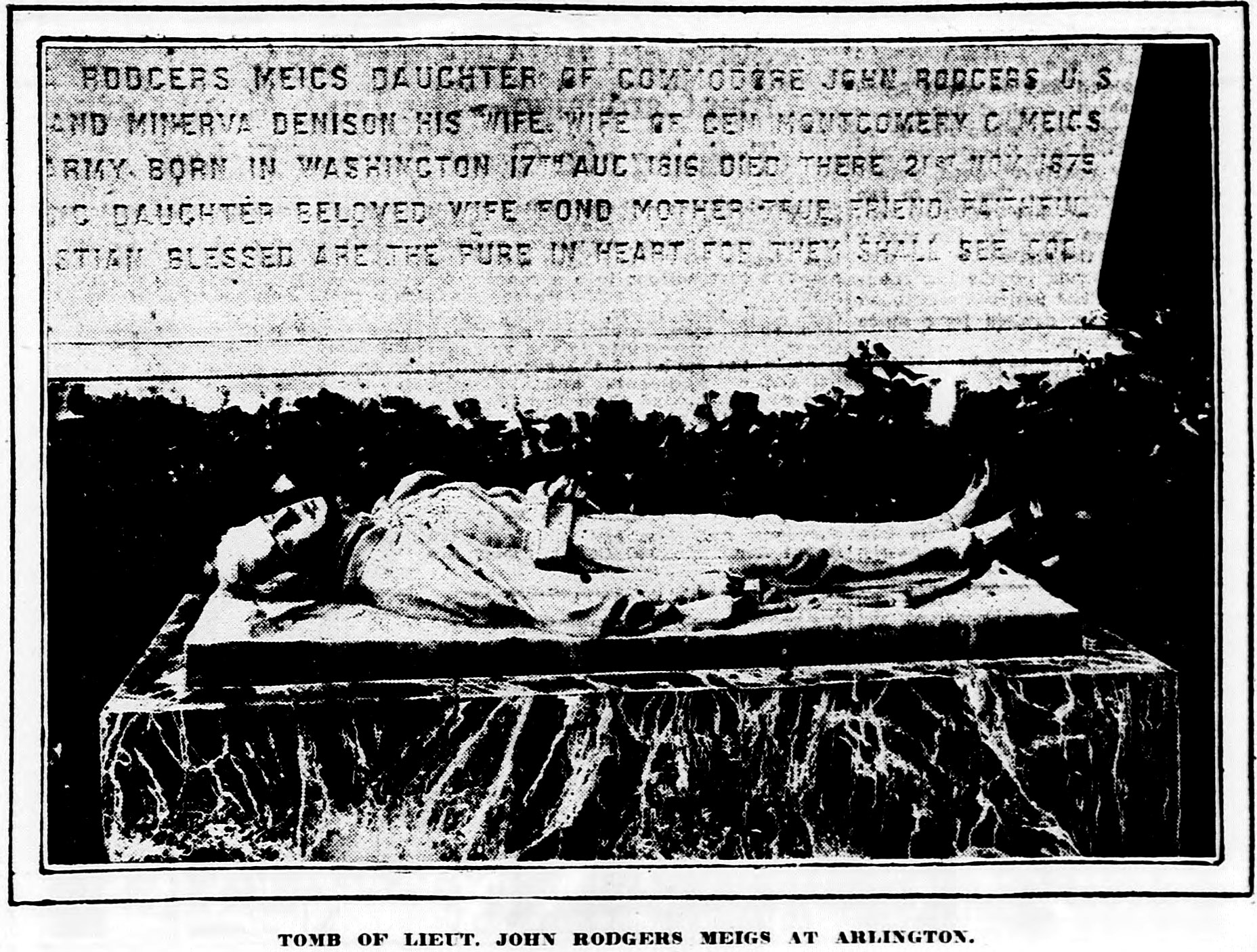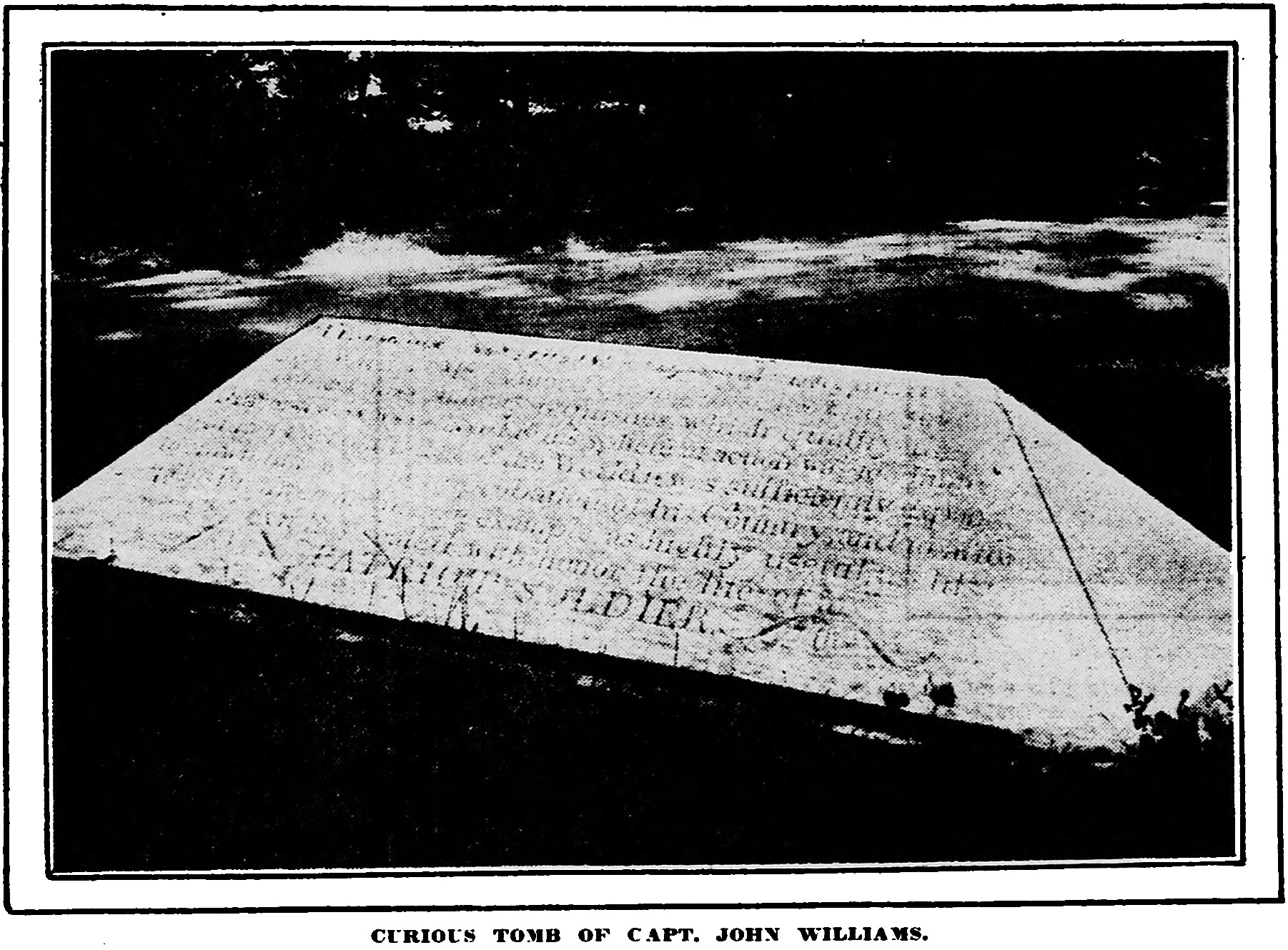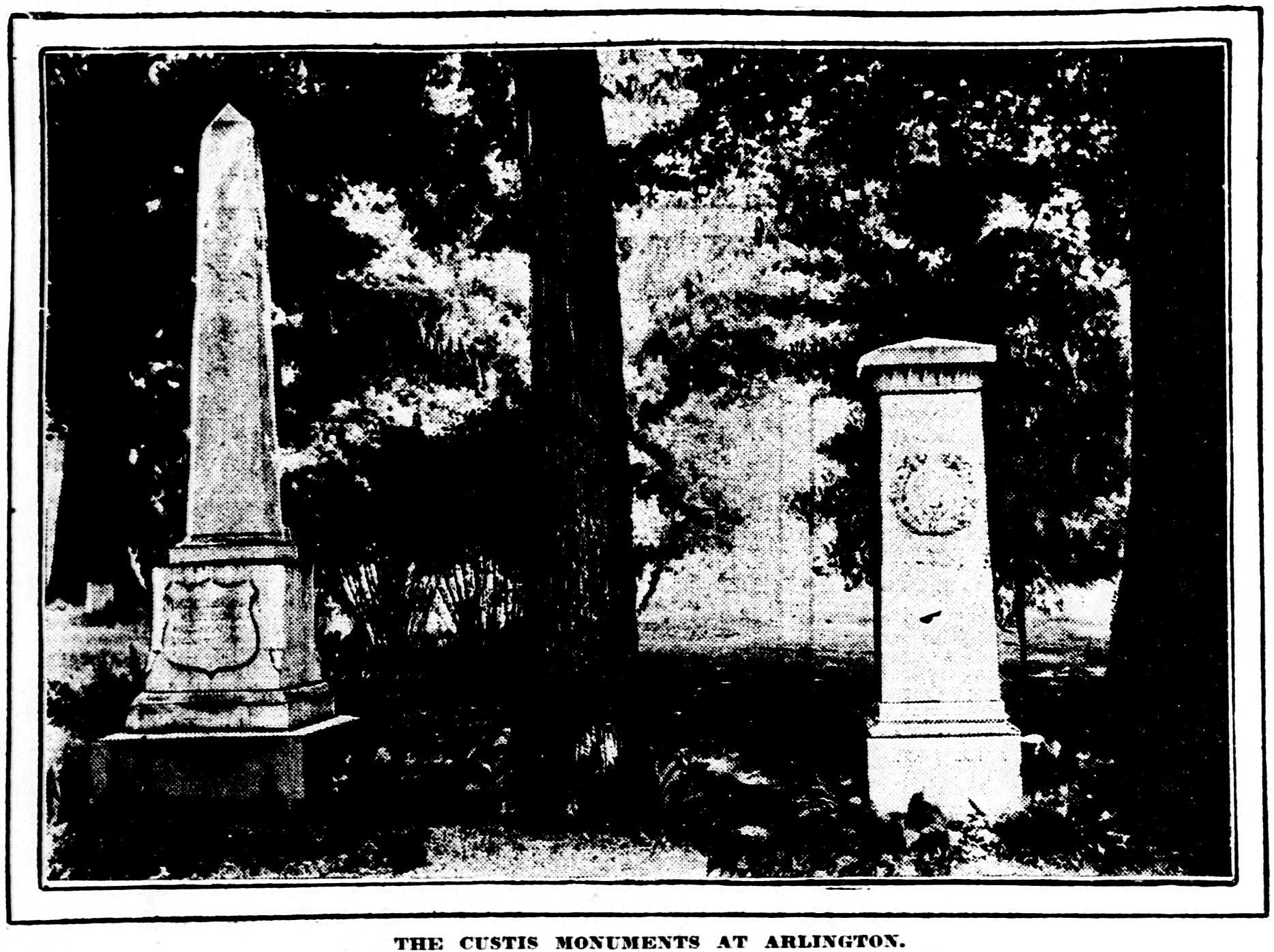IN Arlington, the solemn city of tombs, there are so many silent mansions that the most reverent pilgrim is usually bewildered by the mortuary maze. Perhaps he will contemplate a few monuments and read a few epitaphs, and have some memories recalled by familiar names carved in stone, but either gloom or indifference will take possession of him, and he passes on under the oaks and across the new fields of the dead without getting any distinct and detailed picture. His eye sees monuments and monuments, and more monuments, but does not rest on any particular one, unless perhaps it calls out for notice more strongly than the rest by reason of ts greater height or size.
There are memorials at Arlington which have impressed the Rambler. Some of these are at a distance from the more frequented ways and in relatively remote parts of the grounds, and the Rambler feels that some of these tombs are of interest enough to justify him in telling of them.

Of the very unusual if not the most unusual tomb at Arlington is the bronze effigy of a battle-slain soldier, which rests under the oaks in the officers' older section of the cemetery, north of the main drive and probably about midway between the rear of the mansion and the central west gate, or the gate through which most of the visitors to Arlington enter. This tomb calls up in one's mind the tombs in the abbeys and churches of Europe on which rest the sculptured images of the dead. Most travelers will remember the effigies of warriors and kings clad in armor, that lie above the bones they memorialize.

The Arlington effigy, or the prone statue of a stricken soldier, rests on a beautiful and highly polished marble block of marble of such a dark green that one might call it green-black, and the body of the marble is streaked with white. The bronze image has also turned gray-green by its years of exposure to the weather. The image is clothed in the United States uniform of the officer of the civil war period. An army pistol of bronze lies near the soldier's right hand, as though it has only just fallen from his grasp, and the flap of his pistol holster is open.
The inscription which runs around the edge of the bronze base of the statue is: “Lieut. John Rodgers Meigs, U. S. Engineers. Chief Engineer Army of the Shenandoah, Born 9 February, 3 1842. Killed October, 1864.”
The effigy lies at the base of an ivy grown sarcophagus, which is inscribed as follows: “Louisa Rodgers Meigs, daughter of Commodore John Rodgers Meigs, U. S. Navy, and Minerva Denison, his Wife. Wife of General Montgomery C. Meigs. U. S. Army, born in Washington 17th August, 1816, Died there 24th November. 1879: loving daughter, beloved wife, fond mother, true friend, faithful Christian. Blessed are the pure in heart, for they shall see God.”

In the same lot is a sandstone tomb of the pattern of those tombs and cenotaphs which stand in long and gloomy rows in Congressional cemetery. It would seem to the Rambler that this stone must once have stood in Congressional cemetery, but the story of its removal is not known to him, but may be conjectured. It bears this in scription. “Sacred to the Memory of Josiah Meigs, born 21 August, 1757, Died 4th September, 1822, aged 65 years.” On another face of the monument is inscribed: “Commissioner General Land Office from 11th October, 1814.” Another face of the stone is inscribed: “Samuel W. Meigs, son of Josiah and Clara Benjamin Meigs, 1st December, 1738 — 20th July, 1818.”
In a part of the cemetery where not many pilgrims stray is a curious monument, both in form and in the matter of inscription. The monument is about one foot high. The inscription, which is in that lettering known as “script,” covers the four sides of the monument, and is the longest epitaph in Arlington, and perhaps one of the long epitaphs of the world. Carved on this low but long monument is this:
“Here lie the remains of John Williams, Esq., late a Captain in the Corps of United States Marines. Was born in Stafford County, Virginia, the 24th of August, 1765, and died the 29th of September, 1812, at Camp New Hope, in East Florida. The body of the deceased was removed to this spot, over which his brother officers of the Marine Corps have caused this pile to be erected in testimony of his worth and in their mournful admiration of his gallant end.

“On the 11th of September, 1812, Capt. Williams, on his march with a command of 20 men to Davis Creek Block House in East Florida, was attacked toward evening by upwards of fifty Indians and negroes who lay concealed in the woods. He instantly gave battle, gallantly supported by his men, who, inspired by his animated example, fought as long as they had a cartridge left. At length, bleeding under eight galling wounds and unable to stand, he was carried off the battleground, whilst his heroic little band, pressed by superior numbers, was forced to retreat.
“Eminently characterized by cool intrepidity, Capt. Williams evinced during this short but severe contest those military prerequisites which qualify the officer for command, and if his sphere of action was too limited to attract the admiration of the world, it was sufficiently expanded to crown him with the approbation of his country and to afford to his brethren in arms an example as highly useful as his exit has sealed with honor the life of a Patriot Soldier.”

It is evident that this stone, which is in the war of 1812 section at Arlington, long rested in some other cemetery before its removal to its present site. On the side of a shallow ravine in a retired part of the Arlington grounds, and in a spot around which the privates' section of the cemetery grew up, are the graves and monuments of the builder of the Arlington mansion and the beautifier of the grounds. His wife sleeps beside him. There are two marble monuments which were white long, long ago, and the taller is inscribed: “George Washington Parke Custis. Born April HO, 1781; died October 10, 1857. Blessed Are the Merciful, for They Shall obtain Mercy.” The shaft, separated by an oak tree from that above the grave of George Washington Parke Custis, is inscribed:
“Mary L. Custis, born April 22, 1788; died April 23, 1853. Blessed Are the Pure in Heart, for They Shall See God.”

The man under the taller monument was an adopted son of George Washington and the brother of Nellie Custis, who became Mrs. Lawrence Lewis. George Washington Parke Custis was the son of John Parke Custis, who was the son of Martha Dandridge, who became the wife of Daniel Parke Custis of White House, Va., and after his death became the wife of George Washington. The mother of the man under the taller monument was Eleanor Calvert of Mount Airy, in Prince Georges county, Md. The man and woman resting under these monuments were the father and mother of Mrs. Robert E. Lee, whose maiden name was Mary Ann Randolph Custis, and at the base of the monuments the Rambler has seen growing lilies and myrtle which he fancies were planted there by Mrs. Lee.
The Rambler in previous notes on Arlington has told a good deal about the Custis family and other families related to the Arlington estate, but it may be acceptable to the reader to outline the history of the beautiful place which George Washington Parke Custis and his wife established, which Mrs. Robert E. Lee inherited and which the United States government appropriated and finally, under a decision of the Supreme Court of the United States, paid for to the heirs of Gen. and Mrs. Lee.

It was soon after the marriage of John Parke Custis, Mrs. Washington&apps;s son and George Washington&appos;s stepson, with Eleanor Calvert that he bought from Gerald Alexander a large tract of land on the “hills and lowlands across the Potomac from Georgetown and the future site of Washington. The principal house on this tract was that in which Gerald Alexander lived and which stood on the rise of ground on the lowlands, where are now the buildings appurtenant to the exeriment station of the Department of Agriculture.
Custis built a frame house of no great pretention, rather near the river shore and north of Four Mill run. He called the house and the farm Abingdon. That house, in which Nellie Custis was born, is still standing, being owned by a brickmaking company, and the Rambler has heretofore written of it. Eliza Custis and Martha Custis, elder and perhaps less famous sisters of Nellie Custis, were also born in that old house. George Washington Parke Custis, the brother of these girls and the youngest of the children, was born at his mother's home at Mount Airy.
John Parke Custis had an erratic career, and Washington took him as an aid. He died of fever near Yorktown in 1781, and after that Nellie and George Washington Parke Custis, being very young children, went to live with their grandmother, Mrs. George Washington, at Mount Vernon. Nellie Custis lived there until her marriage, in 1799, to Betty Washington's son, Lawrence Lewis, and George Washington Parke Custis lived there until the death of Mrs. Washington, in 1802. Then he concluded to build a fine mansion on the hills of his father's estate of Abingdon, a mansion which would overlook Georgetown and the new capital. He did not call the place Abingdon, but changed the name to Arlington.
The second Custis in America, who was the son of the emigrant Custis lived in Northampton county. Va., and there he built him a house of some proportions and architectural importance, which he called Arlington. He called the place Arlington not because there had been any Custis associations with such a place, but simply in honor of Henry, Earl of Arlington, a co-grantee with Lord Culpeper of Virginia. Whether this son of the emigrant Custis had had any business with the Earl of Arlington, the Rambler does not know, but his judgment is against the probability of this.

When George Washington Parke Custis had decided to give a name other than Abingdon to his new home he hit on the name Arlington because it had been the name of the first home in Virginia built by a Custis native to Virginia. There may have been some other reason for the selection of the name of Arlington, and perhaps some of the Rambler's friends may have gone more deeply or successfully into this matter than he.
A few years ago, a field piece was put in position as a monument over the grave of a soldier at Arlington. It was a unique thing then, and, so far as the Rambler knows, it is the only memorial of its kind In the great national cemetery. There are Spanish trophy guns in the new section of the cemetery, but these are not grave markers or monuments to individuals. The gun memorial has a bronze plate on the squared oak trail which is inscribed: “Wallace Fitz Randolph. Major General United States Army, June 11, 1841 — December 9, 1910.” The field piece is brass and was cast in 1862 and no doubt performed service from the second until the last year of the civil war.

Correspondents and the Rambler.
THE mail of the Rambler has already assumed considerable proportions and the indications seem to be that it will continue to increase. A few of the correspondents give information on subjects of which the Rambler has previously written, some contain suggestions for future rambles, and by far the greater number contain requests for information. And the Rambler is happy to furnish the information when he has it or knows where and how to get it without too great expenditure of time.
A large percentage of the letters in which correspondents ask for information contain requests for data concerning ancestors. The necessary inference is that a goodly number of Washingtonians are actively interested in their ancestors and that interest in genealogy is spreading and deepening.
A woman has written: “Several weeks ago I read your account in The Star of the Youngs over in Maryland and I destroyed the paper before I had sufficiently read it. Now I should like to ask you if you obtained the records mentioned from a Maryland court or from a District court. This is of personal interest to me and if you would give me this information I should be more than grateful.”
A woman in Alexandria has written: “I have been reading your articles in the Sunday Star with much interest, particularly your rambles near Alexandria, my birthplace and the home of my family for six generations. In your letter of last Sunday you spoke of a Thompson family in Maryland. Will you tell me where I can find records of this family? I am in quest of an elusive ancestor and hope to trace him through a Thompson family of Maryland. This may be the one I seek. I will esteem it a great favor if you will tell me where the records of these Thompsons can be found. I would want to go back prior to 1765.”
A woman writes from the Louise Home that she would like to get a picture of the old Kalorama house and gateway and of the oid Cox house which stood on Meridian Hill.
A man in Washington writes: “I have been reading with much interest the articles by the Rambler. They are particularly interesting to me, for I am a newcomer here, coming from Boston two years ago, and I am anxious to learn about the noted places in and about the District. Recently I have been seeking information about Tudor House, but have found only very meager references to it. It has been suggested to me that probably you could point out to me the sources from which the desired information could be gathered.”
Whenever the Rambler comes into possession of information sought by his correspondents he will pass it along to them with great pleasure.

John Sarten Again.
IT is always pleasant to welcome old friends and to record their return. Several Sundays ago the Rambler reached into his great and odd collection of photographic negatives and drew from the heap four negatives of old friends, young and old persons he had encountered on the rambles. Some of these negatives were made several years ago. One of the pictures which he turned in with his “ramble” was that of an old man in a high-peaked, rough-and-ready hat, and wearing on his shoulders a military cape of a cut and style that is not now the military vogue. His name was John Sarten. The Rambler met him on a street in Alexandria, made his acquaintance and took his picture. Recently in an idle mood when it seemed more pleasant to indulge in reminiscences than to go walking after new matter, the Rambler wrote of this old man, saying that perhaps he had passed away, because he was not a young man at the time of the making of the picture.
The mail a few days ago brought to the desk of the Rambler the following letter:
Dear Sir:
In looking over The Sunday Star of January 24 I was very much interested in an article of the Rambler. The quaint old man with the cape on happened to be my husband's grandfather and from the way the article read I am aware you think he has passed away, and I am very glad to tell you he is still very much alive and is almost as active as he was when you took his picture in Alexandria.
He is still living on his farm near Franconia Va., all alone, and I am writing this to you that if you ever care to visit him in your rambles again you will know where to find him. He still remembers when you took his picture and also has the one you sent him.

